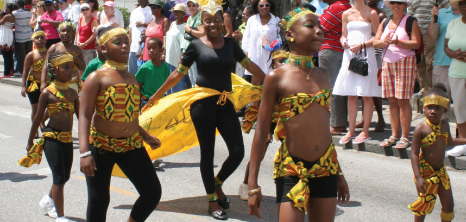|
African InfluenceBarbados became exposed to African influence some time back in 1627 when a few of them came ashore with English slave masters. Barbados' very foundation was built by sugar plantations being cultivated and buildings being constructed by these same African slaves. Chattel houses were built by African slaves as this type of structure was most suitable to be moved from plantation to plantation should the need arise.
In early days, sugar production in Barbados has played a rather presiding role in being the economic foundation for the island. After all, for over three hundred (300) years, African slaves were responsible for planting these fields and hills that we now call our very own. They not only cut the sugar cane but they also pushed away debris from the land. Needless to say, African slaves were very much a major part of honing the agricultural structure of Barbados.
Once sugar cane is mentioned, one certainly can't forget Barbados' Crop Over Festival which carries a heavy African influence. Regarded as Barbados' largest cultural festival, this three (3) week-long festival starts in July and includes parades, contests and fairs that all pay homage to the traditional harvesting of sugar cane on the island. The climax of Barbados' Crop Over Festival is seen with revellers taking to the streets in all kinds of creative costumes. A big part of the Crop Over Festival is the sweet sounds of calypso. Calypso music is not only an integral aspect of the Crop Over Festival but it is also another element that creates a connection between Africa and Barbados.
The arts and cultural characteristic of Barbados is very much moulded as a result of African influence. The ingenuity their possess was often time seen in the pottery they produced, the clothes they made and the baskets they weaved. All of which are still very much a part of ou
In 1838, life in Barbados saw favourable contributions from just about 70,000 freed slaves. These slaves were now able to operate in an unencumbered way as there were no physical chains to control their movement. Growth throughout the island was so significant that by 1843, the Legislative Assembly opened its doors to the first non-white member.
During and after the slave period, strong emphasis was placed on the importance of eating the very food that was planted and even drinking teas that were and still are considered bush teas. These teas were used for their medicinal and nutritious properties by African slaves. Today we hear constant mention of the importance of such a lifestyle being made public by the likes of Annette Maynard-Watson, a secondary school teacher in Barbados who collects Barbadian herbs, researches their medicinal properties and offers advice on how best to use them for self-healing purposes.
The introduction of cou-cou to the island is also another aspect of African influence. Made from cornmeal (a protein element) and stirred until it becomes a porridge type consistency, this staple food has now become the national dish of Barbados when combined with flying fish.
00-2
|



